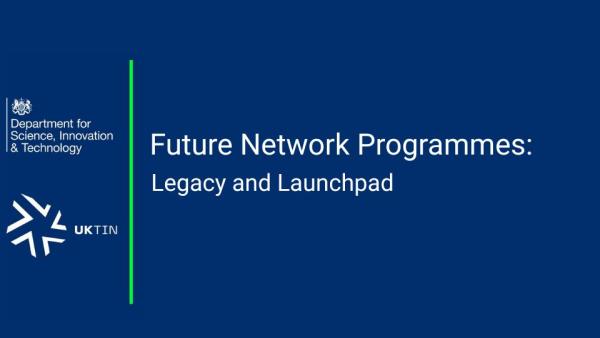
Poonam Parihar is an experienced tech industry professional and founder of bandarlog.dev, a deep-tech start-up working to transform telecoms through AI and build digital network automation solutions to help SMEs in other sectors adopt next-generation technologies more quickly. She studied Information Technology and has worked in the tech industry for over 20 years in software development and sales engineering for Cisco, AT&T, and Keysight.
She has previously participated in the UK Telecoms Innovation Network (UKTIN) support for early-stage companies, which is delivered by the University of Bristol alongside SETsquared.
How did you find the UKTIN innovation and investment support, and what value did you get from it?
I moved to the UK in late 2020 to be with my family, and I had a plan for a start-up. It took me about a year to figure out the technology landscape, how it was evolving, the business opportunities available, and the financial, investor, and business support I’d need to launch my start-up.
I was introduced to Innovate UK when I exhibited at Connected Britain in 2022, which led me to find mentorship and join their high-growth programme in April 2023. As I was discovering more about Innovate UK and building my network, I was invited to the UKTIN launch event and then to join the first cohort of emerging deep-tech start-ups on the Innovation and Investment workouts (now known as Commercialisation Through Partnerships and Investment Support).
The two workouts across four days covered everything a founder needs to know about building a start-up strategy, as opposed to attending lots of different business programmes run by different organisations. The workouts helped me build my business model, understand the components of a pitch deck from an investor’s perspective and delve deeper into my value proposition.
The programmes are also important for validation – when you have a start-up, you have lots of ideas and are looking for investment. You need to understand the gaps, where you are exactly and what you lack. Is your business model good? What’s your market strategy? What’s your cost structure and revenue model? It’s extremely important to understand when you should start funding rounds and if you’re on track with the right documents in your data room. The workouts are an excellent opportunity to reflect on where you are now on your start-up journey and where you want to be, and they take you step-by-step through the whole process.
The support has now been transitioned to online blended learning. Would you recommend that other founders take part?
At the time I attended the workouts, I was able to dedicate the hours to them on consecutive days, but if you asked me to attend a two-day workshop now, it would be very difficult, and I wouldn’t be able to commit the time due to workload. I think the blended learning approach, therefore, does create more flexibility and allows founders to fit the learning around the demands of their business. But founders, especially very early stage and first-time founders, should absolutely dedicate time to learning to develop their business right away and be prepared to work very hard to move it forward.
Why did you decide to apply your technology to the telecoms industry?
I have an extensive technical background and have worked for major telecoms companies in the USA, including AT&T, Verizon, and Comcast, so I understand the trajectory of where the technology is going and the aspirations for 6G and the metaverse. The telecoms industry is my bread and butter and so I felt confident about leveraging my expertise and applying my experience to my start-up.
The application of AI is not new to the telecoms industry. However, most of the developments in AI have been generative AI, and there’s potential for so much more. We can use network automation and integrate AI into the core of the network, which will make the network smarter and more efficient. We can also use AI with edge computing to build better services and applications for consumers, and that’s what bandarlog.dev is doing. Automation has been around for a long time; in fact, I started my career building automation frameworks for routers at Cisco about 20 years ago. Now that the networks are becoming increasingly complex and expensive with heavy bandwidth demand, it’s vital that we focus on a network architecture design that‘s open and scalable to enable it to sustain the growth that we’re anticipating in both the creator and industrial economy over the next ten years.
Why is telecoms an exciting sector?
Ultimately, I think it all comes back to connectivity. We are always looking for better speed and quality of service. We need to communicate and be able to work and this requires a better network that is smarter and faster. It’s vital therefore that we get the direction and speed of development in telecoms right to handle the growth that is anticipated by 2030.
Many industries are behind, and many SMEs don’t have proper IT infrastructure or lack connectivity. Rural areas can be included in this. They need a new and upgraded infrastructure to cope with next-generation applications and increasing consumer demands. The network is an integral part of this and any business journey—they will all need better connectivity, and you achieve this through telecoms.
You’re a trailblazer in your industry. What’s it like working as a female solo entrepreneur?
The technology industry is predominantly male, and the technology business gender ratio is similar. It’ll take us a while and a lot of effort and open communication to reach equilibrium, especially in leadership roles. Since being in the UK, I’ve struggled to meet other female technical founders working in deep tech. There are women at the centre of university spin-outs, or in-house projects which receive grant funding and support, but if you look at just solo female deep tech founders with industry experience and ambition to innovate and build a technology business – it’s incredibly limited, and that needs to change.
I recently attended an accelerator programme and met 100 female founders, most of whom were working on technology use cases in sectors such as HR, health, non-profit, and small consumer businesses. There are definitely females working in deep tech and the telecoms sectors, and they are very talented and very good at their jobs.
We need to do more to identify and support female deep tech founders because it’s a very tough road. Developing innovative tech is already difficult, doing it solo takes those challenges to another level. It needs a lot of courage and extra effort on the woman’s part to start a venture. To do that in a country you’ve never been to, you’re starting from scratch. I moved to the UK as an Exceptional Talent technology leader, yet I had to work very hard to understand this market and its needs, network with the right people, prove both my technical and business abilities and find the support I needed to run my start-up.
This is why UKTIN support is so important. It helps you start off on the right foot in executing your business idea and going about your investment journey in the right way.









